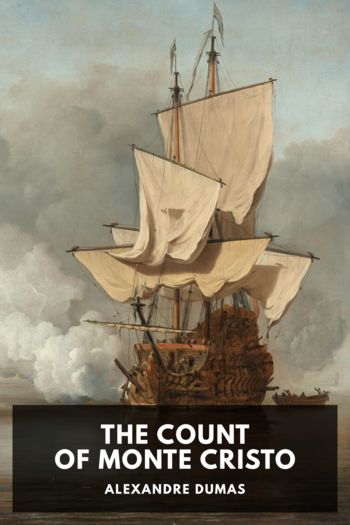The Count of Monte Cristo, Alexandre Dumas [buy e reader TXT] 📗

- Author: Alexandre Dumas
Book online «The Count of Monte Cristo, Alexandre Dumas [buy e reader TXT] 📗». Author Alexandre Dumas
Brucea ferruginea. ↩
“Money and sanctity,
Each in a moiety.”
↩
Elisabeth de Rossan, Marquise de Ganges, was one of the famous women of the court of Louis XIV where she was known as “La Belle Provençale.” She was the widow of the Marquis de Castellane when she married de Ganges, and having the misfortune to excite the enmity of her new brothers-in-law, was forced by them to take poison; and they finished her off with pistol and dagger. —Ed. ↩
Magistrate and orator of great eloquence—chancellor of France under Louis XV. ↩
Jacques-Louis David, a famous French painter (1748–1825). ↩
Ali Pasha, “The Lion,” was born at Tepelini, an Albanian village at the foot of the Klissoura Mountains, in 1741. By diplomacy and success in arms he became almost supreme ruler of Albania, Epirus, and adjacent territory. Having aroused the enmity of the Sultan, he was proscribed and put to death by treachery in 1822, at the age of eighty. —Ed. ↩
Or, word for word: “Of thy father the fate, but not the name of the traitor or the treason, relate to us.” ↩
“Speak.” ↩
Greek militiamen in the war for independence. —Ed. ↩
A Turkish pasha in command of the troops of a province. —Ed. ↩
The god of fruitfulness in Grecian mythology. In Crete he was supposed to be slain in winter with the decay of vegetation and to revive in the spring. Haydée’s learned reference is to the behavior of an actor in the Dionysian festivals. —Ed. ↩
The Genoese conspirator. ↩
Lake Maggiore. ↩
In the old Greek legend the Atreidae, or children of Atreus, were doomed to punishment because of the abominable crime of their father. The Agamemnon of Aeschylus is based on this legend. ↩
The performance of the civil marriage. ↩
In Molière’s comedy, Le Misanthrope. ↩
Literally, “the basket,” because wedding gifts were originally brought in such a receptacle. ↩
Germain Pillon was a famous French sculptor (1535–1598). His best known work is The Three Graces, now in the Louvre. ↩
Frédérick Lemaître—French actor (1800–1876). Robert Macaire is the hero of two favorite melodramas—Chien de Montargis and Chien d’Aubry—and the name is applied to bold criminals as a term of derision. ↩
The Spahis are French cavalry reserved for service in Africa. ↩
Savate: an old shoe. ↩
Guilbert de Pixérécourt, French dramatist (1773–1844). ↩
Gaspard Puget, the sculptor-architect, was born at Marseilles in 1615. ↩
The Carolina—not Virginia—jessamine, Gelsemium sempervirens (properly speaking not a jessamine at all) has yellow blossoms. The reference is no doubt to the Wistaria frutescens. —Ed. ↩
The miser in Molière’s comedy of L’Avare. —Ed. ↩
ColophonThe Count of Monte Cristo
was published in 1844 by
Alexandre Dumas.
It was translated from French in 1846 by
Chapman and Hall.
This ebook was produced for
Standard Ebooks
by
Vince Rice,
and is based on a transcription produced in 1998 by
An Anonymous Volunteer, Dan Muller, and David Widger
for
Project Gutenberg
and on digital scans available at
Google Books (Volume 1, Volume 2).
The cover page is adapted from
The Cannon Shot,
a painting completed in 1680 by
Willem van de Velde the Younger.
The cover and title pages feature the
League Spartan and Sorts Mill Goudy
typefaces created in 2014 and 2009 by
The League of Moveable Type.
The first edition of this ebook was released on
February 11, 2021, 7:17 p.m.
You can check for updates to this ebook, view its revision history, or download it for different ereading systems at
standardebooks.org/ebooks/alexandre-dumas/the-count-of-monte-cristo/chapman-and-hall.
The volunteer-driven Standard Ebooks project relies on readers like you to submit typos, corrections, and other improvements. Anyone can contribute at standardebooks.org.
UncopyrightMay you do good and not evil.
May you find forgiveness for yourself and forgive others.
May you share freely, never taking more than you give.
Copyright pages exist to tell you can’t do something. Unlike them, this Uncopyright page exists to tell you, among other things, that the writing and artwork in this ebook are believed to be in the U.S. public domain. The U.S. public domain represents our collective cultural heritage, and items in it are free for anyone in the U.S. to do almost anything at all with, without having to get permission. Public domain items are free of copyright restrictions.
Copyright laws are different around the world. If you’re not located in the U.S., check with your local laws before using this ebook.
Non-authorship activities performed on public domain items—so-called “sweat of the brow” work—don’t create a new copyright. That means nobody can claim a new copyright on a public domain item for, among other things, work like digitization, markup, or typography. Regardless, to dispel any possible doubt on the copyright status of this ebook, Standard Ebooks L3C, its contributors, and the contributors to this ebook release this ebook under the terms in the CC0 1.0 Universal Public Domain Dedication, thus dedicating to the worldwide public domain all of the work they’ve done on this ebook, including but not limited to metadata, the titlepage, imprint, colophon, this Uncopyright, and any changes or enhancements to, or markup on, the original text and artwork. This dedication doesn’t change the copyright status of the underlying works, which, though believed to already be in the U.S. public domain, may not yet be in the public domain of other countries. We make this dedication in the interest of enriching our





Comments (0)